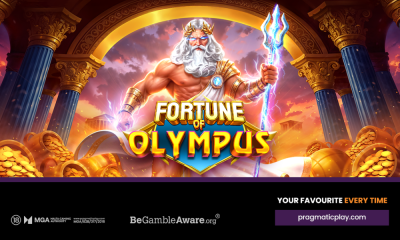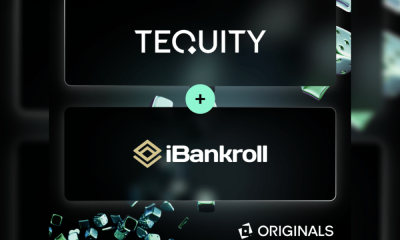GameOn
Virtuals and the TikTok Effect: How Short-Form Play is Redefining the Sportsbook

Kiron Interactive’s Head of Marketing, Patrick Eriksen, on why the future of sports betting isn’t long-form odds and live matches. It’s short-form, always-on, instant-return gameplay.
Short-form content has changed everything. We no longer wait for results, we scroll, we swipe, we move on.
Yet, most sports betting still takes 90 minutes to settle.
Most sportsbooks still rely on long-form bets, match winners, final scores, total points, with outcomes that take an hour or more to resolve.
That may suit traditional punters, but for modern players it’s increasingly out of step.
Virtual sports flip the script. Matches play out fast, bets settle in minutes, and the action never stops. They offer the sports betting equivalent of short-form video.
Operators who have added virtuals are already seeing the benefit. They’re gaining faster engagement, a wider player base, and stronger retention. For those who haven’t, the opportunity remains wide open.
Fast by design. Ready for now.
Today’s audiences are used to fast-moving, always-available entertainment. Whether it’s videos, games or live streams, the expectation is instant access and quick outcomes. Virtuals deliver both.
Players engaging with virtuals tend to prefer faster outcomes and simpler formats. Many are looking for quick resolutions and low-friction experiences. They don’t want to sit through a full match. Virtual matches last just a few minutes, with a wide range of betting markets to explore.
And it’s not only about speed. Simplicity matters too. There’s no fixture list to follow, no downtime between games, and no dependence on real-world scheduling. Players can place a bet, get a result, and move on. All of this takes less than five minutes.
That’s why virtuals align so well with how players consume content today.
Short sessions. Easy returns. Ongoing engagement.
Unlike traditional sports, virtuals aren’t restricted by time zones, calendars, or matchday delays. They run 24/7, all year round.
We regularly see player activity climb when real events are off the board, whether that’s during the off-season or on a quiet weekday afternoon.
Because matches are short and always available, virtuals invite casual, repeat engagement. Players dip in for a quick play, try new markets, and often come back for more.
This leads to higher bet frequency and longer session times. It gives players more reasons to stay and explore. And in today’s landscape, where acquisition costs are rising, that kind of stickiness is key.
Like short-form media, virtuals offer fast, familiar loops that players can jump into anytime. They’re fast, easy to understand, and satisfying to return to. That’s how today’s audiences engage with content across the board. And that’s why this format feels familiar to digital-first players.
The next wave of virtuals
In regions where virtuals are already well established, we’re seeing a new phase of innovation.
This includes live-style virtuals with in-play markets, branded leagues with recognisable identities, and hybrid formats that combine sports with game mechanics.
At Kiron, we’re building visually rich, quick-play virtual formats that reflect how audiences already consume mobile and interactive content.They give operators a new way to deliver something fresh and distinctive. And in a category where standing out matters, that’s a big advantage.
A proven way to meet the moment
As always, the best results come when content is engaging, responsible, and designed with the player experience in mind. Virtuals aren’t throwaway content. They’re a core pillar of the modern sportsbook experience.
They work alongside live sport by keeping the lobby active when real matches aren’t taking place. They’re easy to access, simple to understand, and always available.
Virtuals aren’t just catching up with the way people play. They’re meeting it head-on.
The post Virtuals and the TikTok Effect: How Short-Form Play is Redefining the Sportsbook appeared first on Gaming and Gambling Industry in the Americas.
AI
Movers and Shakers – From Data to Decisions: What It Really Takes to Make AI Work in iGaming

Reading Time: 3 minutes
“Movers and Shakers” is a dynamic monthly column dedicated to exploring the latest trends, developments, and influential voices in the iGaming industry. Powered by GameOn and supported by HIPTHER, this op-ed series delves into the key players, emerging technologies, and regulatory changes shaping the future of online gaming. Each month, industry experts offer their insights and perspectives, providing readers with in-depth analysis and thought-provoking commentary on what’s driving the iGaming world forward. Whether you’re a seasoned professional or new to the scene, “Movers and Shakers” is your go-to source for staying ahead in the rapidly evolving iGaming landscape.
By Claudia Heiling, Co-Founder & COO, Golden Whale
For years, iGaming has considered itself a data-driven industry. We’ve all spent time refining segmentation, optimising CRM journeys, mapping behavioural signals, and building increasingly complex player models. And with machine learning now widely available, whether bought, built, or borrowed, it would be reasonable to assume that the industry is already fully realising the benefits of AI.
But speak to most operators, product teams, or data leads and you’ll hear a different story.
There are models running somewhere – and usually several. There are predictions being generated. There are dashboards, reports, and insights circulating. Yet the business impact often feels inconsistent. Some initiatives deliver a clear uplift; others stall or never make it past a proof-of-concept stage. Projects that shine in testing environments don’t always translate into live, reliable operations.
The issue is rarely the model. And it’s rarely the data team. The gap is operational.
It’s one thing to build machine learning models. It’s another to make them function as part of the daily working rhythm of an iGaming business.
The operators and providers seeing the strongest and most reliable gains are the ones who treat AI not as an experiment, but as a capability: something that must be designed, deployed, monitored, re-trained, and continuously improved. This is closer to how we already treat core game operations, promotional systems, risk tooling, or CRM orchestration. It’s iterative, structured and ongoing.
In practice, that means building the frameworks around the models, not just the models themselves. Continuous data flows. Automated re-training. Real-time deployment pipelines. Feedback loops that allow systems to learn not just once, but constantly. When we work with iGaming clients who have embraced this operational mindset and leverage our ready-to-deploy MLOps system built for iGaming, the impact becomes both compounding and predictable.
The other shift happening is cultural. There has been a lingering expectation in some corners of the industry that AI will replace manual decision-making entirely and that it will “take over” processes like CRM optimisation, fraud detection, or product adjustment.
That’s neither realistic nor particularly desirable.
iGaming is too contextual, too human, too dependent on craftmanship and intuition.
The real value of AI is in augmentation: giving teams better visibility, faster feedback, and stronger evidence on which to base decisions.
In organisations where this mindset has taken hold, you see a different dynamic.
CRM teams run more experiments, more often, because they aren’t spending time rebuilding segments from scratch. Analysts spend less time on manual spreadsheet simulation and more on strategic exploration. Live-ops managers can respond to player behaviour as it changes, not after the weekly report comes in.
AI becomes the layer that enhances judgement, rather than replaces it.
And when AI is integrated technically and culturally, the commercial outcomes are hard to ignore. In setups where continuous learning pipelines are properly established and aligned with live operations, we’ve seen engagement and retention metrics improve dramatically and sustainably, with activity and revenues rising by 100–200%, while bonus and incentive costs drop by 20%+, driving growth and both securing and expanding market share. Operational teams benefit too, with workflows becoming smoother and less manual because the system is handling the constant data processing and iteration.
The improvements don’t come from having more complex algorithms. They come from having a structure that allows those algorithms to perform reliably, adapt to change, and keep learning over time.
This is where the conversation about AI in iGaming is quietly changing.
It’s no longer dominated by model performance or dataset scale, rather it is focused on repeatability, reliability and learning speed.
The distinction matters because it separates having AI, from running AI.
And the operators and providers who get this right aren’t just improving performance in the short term. They are building organisational momentum, a capability that compounds over time and is very difficult to replicate quickly.
In a sector defined by tight margins, competition and rapidly shifting player expectations, that advantage is significant.
So, if there is a “next step” in the industry’s AI journey, it’s not a more complex algorithm. It’s not a bigger data pool. And it’s not a new suite of predictive dashboards.
It’s the ability to learn continuously, responsibly and at scale.
Because in iGaming, as in intelligence, data alone doesn’t win. What wins is the ability to turn learning into action again and again.
The post Movers and Shakers – From Data to Decisions: What It Really Takes to Make AI Work in iGaming appeared first on European Gaming Industry News.
BETER
Movers and Shakers: 24/7 Content, Strict Integrity, and Constant Feedback – BETER’s Approach to Sustainable Partnerships

Reading Time: 4 minutes
“Movers and Shakers” is a dynamic monthly column dedicated to exploring the latest trends, developments, and influential voices in the iGaming industry. Powered by GameOn and supported by HIPTHER, this op-ed series delves into the key players, emerging technologies, and regulatory changes shaping the future of online gaming. Each month, industry experts offer their insights and perspectives, providing readers with in-depth analysis and thought-provoking commentary on what’s driving the iGaming world forward. Whether you’re a seasoned professional or new to the scene, “Movers and Shakers” is your go-to source for staying ahead in the rapidly evolving iGaming landscape.
We spoke with Oleg Onegov, Head of Strategic Partnerships & Account Management at BETER, about the fast-betting provider’s approach to cultivating, strengthening, and sustaining relationships with partners.
Can you tell us about your career journey and your current role as Head of Strategic Partnerships & Account Management at BETER?
I’ve been working in the betting and iGaming industry for several years, mainly focusing on client relations and business development. Over time, I realised that my strongest skill was in building long-term partnerships and helping clients derive real business value from the products they use. At BETER, I lead the Strategic Partnerships & Account Management team, focusing on ensuring we deliver not only content but also help operators and aggregators grow with it—whether through improved integrations, new products, or data-driven insights. This is critical to scaling BETER’s presence in the esports and sports ecosystem. My role also sees me work closely with internal and external stakeholders to deliver value-driven solutions that support operational excellence and long-term commercial goals.
Different operators and aggregators have different needs. How do you and your team ensure that BETER’s products and solutions remain in demand and are continuously aligned with each client’s evolving business and market changes?
BETER is renowned for providing 24/7 live streaming, real-time data, and hyper-accurate odds for approximately 700,000 fast-paced esports and sports events annually, offering up to 50 markets per event with an average operator margin of 7.5% or higher.
Our esports portfolio includes ESportsBattle tournaments featuring eFootball, eBasketball, eHockey, and eTennis. Our sports portfolio includes the Setka Cup table tennis series, BSKT Cup basketball league, GTR Cup tennis tournaments, and Padel tennis, as well as coverage of official cricket tournaments and leagues worldwide.
In addition to our fast-paced content, we offer a comprehensive Esports Odds Feed, delivering market-leading odds with the highest uptime for more than 450 tournaments worldwide. This includes over 40,000 pre-match and live events annually across popular titles such as CS 2, Dota 2, League of Legends, Valorant, and more.
We are also continuously working on obtaining regulatory approvals in all major markets globally, including U.S. states such as New Jersey and Colorado, where our content is live on bet365’s local domains.
When it comes to ensuring that our products remain in demand and aligned with each client’s evolving business and market changes, our approach is never “one size fits all.” My team and I maintain close communication with every partner to ensure we’re consistently meeting their needs. Some clients aim to maximise esports engagement, others focus on traditional sports, while some want to experiment with new formats such as eTennis or Padel—or even launch fully branded, customised tournaments like our dedicated eFootball series designed specifically for operator needs.
We constantly review performance data, align on KPIs, and adjust delivery or features accordingly. Moreover, our product roadmap is highly flexible—we prioritise developments that bring the most value to our clients’ business models. Ultimately, close collaboration with operators and aggregators helps us understand regional specifics and tailor our products to different markets, while our agility in implementation and regulatory readiness give partners confidence that BETER’s solutions will continue to fit their evolving needs.
Many companies emphasize client success at the start of a relationship, but sustaining it over time is much more challenging. What specific processes, practices, or approaches does BETER use to support clients throughout the entire journey and ensure that partnerships grow into long-term, trust-based relationships?
At BETER, client success is ongoing. My team runs regular business reviews and performance check-ins, where we don’t just present numbers but also propose explicit next steps. We involve product managers at the beginning of new partnerships, so clients can see how their feedback translates into real improvements. Transparency is also key, and we share daily reports, monitor incidents in real time, and communicate openly if something needs fixing. This kind of consistency and accountability builds trust and makes our partnerships long-lasting.
Feedback loops are vital. How does BETER work with client feedback, and in what ways does it influence your product development and solution improvements?
Feedback is at the core of how we evolve. We collect it in various ways, including through structured NPS surveys, regular calls, daily chats, and even during integration discussions. Every input gets logged and shared across product, trading, and IT teams.
Many of our most successful launches, such as new esports markets for Dota 2 and CS 2 titles in our coverage of tournaments worldwide, came directly from client requests. Our eTennis series also originated from a product discussion sparked by a client’s feedback, which expressed the need for completely new offerings for their bettors.
What matters is not just listening, but also closing the loop and showing the client how their feedback shaped the roadmap and what the result looks like in practice.
What are the most important pillars of BETER’s operations that operators or aggregators pay the most attention to—both when entering into a partnership and throughout the entire collaboration?
From my experience, there are four pillars clients care about most.
First is content quality and variety — at BETER, we offer fresh and engaging disciplines such as eFootball, eBasketball, and eTennis, supported by diverse game formats.
Second is reliability, especially when it comes to uptime, latency, and the accuracy of our data feeds and live streams. That’s why our team works tirelessly to maintain the highest possible uptime across all our products.
Third is integrity and compliance — operators need confidence that the product is fair, transparent, and secure. Our dedicated Integrity team ensures that only 0.01% of matches have been flagged as suspicious.
Finally, there’s our approach to partnerships — we’re not just a provider; we act as an extension of our partners’ teams, ready to adapt and innovate together.
This combination of high-quality content, operational excellence, trust, and genuine collaboration is what keeps our partnerships strong from day one — and well into the future.
The post Movers and Shakers: 24/7 Content, Strict Integrity, and Constant Feedback – BETER’s Approach to Sustainable Partnerships appeared first on European Gaming Industry News.
Acquire.bet
Movers and Shakers: The future of player acquisition

“Movers and Shakers” is a dynamic monthly column dedicated to exploring the latest trends, developments, and influential voices in the iGaming industry. Powered by GameOn and supported by HIPTHER, this op-ed series delves into the key players, emerging technologies, and regulatory changes shaping the future of online gaming. Each month, industry experts offer their insights and perspectives, providing readers with in-depth analysis and thought-provoking commentary on what’s driving the iGaming world forward. Whether you’re a seasoned professional or new to the scene, “Movers and Shakers” is your go-to source for staying ahead in the rapidly evolving iGaming landscape.
Allan Petrilli, Managing Director at Acquire.Bet, talks about paid media and the trends shaping customer acquisition in the regulated North American market
Paid media is very much the future of player acquisition in the regulated North American market, but running successful campaigns is not without its challenges.
More than ever, operators and marketers need to nail not only their creatives and messaging but also the measurement and tracking of campaigns.
Paid channels control much of the campaign and ad targeting, but with stricter privacy rules in play, it’s becoming increasingly difficult to target directly based on a user’s preferences.
Creative fatigue is as real as it is prevalent, so operators and marketers need to achieve creative iteration at scale, not only in terms of volume but also creative types and formats.
Just as important is having measurement dialed in and being able to inform the platforms of what is working – this means having a ton of actionable data at your fingertips so you can quickly decide where to spend your ad dollars.
Then there’s incrementality and uplift, which can’t be ignored, either.
The platforms themselves are starting to take more “credit” for conversions, so being able to zoom out and understand multitouch is key to making the marketing budget go further and perform better.
The great SEO slowdown
Paid media is becoming increasingly important in player acquisition efforts because there is a clear SEO slowdown. This, combined with advancements in generative AI in search, means brands are going to have to rely more on communities for growth.
Influencer marketing is no longer just getting some with a decent following to promote your brand, with micro influencers becoming a very important piece of the puzzle.
It’s also worth highlighting Discord here as it’s starting to play a significant role, especially in sports betting. This channel is all about community and trust, and we are seeing some really smart partnerships play out across the platform.
Regardless of platform and channel, operators must understand the power of their brand and that by aligning with influencers and communities that match their values, they can supercharge growth.
The only caveat here is that these partnerships need to be authentic.
Market maturation brings new challenges
As the North American market matures, we see the establishment of standard success KPIs, but it’s important that each brand really understands its own LTV and CAC data so that it can drive towards hitting its own success metrics and not just “industry” standard KPIs.
Why? Because those industry standard KPIs are often skewed by the power players that have spent big to get to where they are today, and won’t be reflective of smaller operations and brands.
It’s also important to focus on incremental growth as the market matures, understand the power of multi-touch and how each channel supports the overall acquisition strategy. Operating in silos is a recipe for disaster.
In addition to this, operators need to have a clear view of their runway – those with considerable cash can operate in more aggressive ways than brands that are relying on quick growth to fund future spend.
Ultimately, there’s no one-size-fits-all approach, and that’s why operators must focus on their own metrics for success and not industry-standard KPIs. They also need to remember that while being nimble is key, being relentlessly focused on data is what will allow them to win.
Regulations do influence player acquisition strategies, but everyone plays the same game
A lot of times, operators will focus on regulation and compliance to make excuses as to why they market one way or another, but the reality is that everyone is playing in the same sandbox and under the same rules.
How marketers push those boundaries, and to the extent they are willing to get creative, is what separates those who succeed and those who don’t.
Take Ontario, for example. You can’t promote the welcome bonus, so brands are having to engage players in other ways – those with kick-ass product marketing campaigns or that offer something truly unique are winning right now.
Of course, paid media is the perfect channel through which to communicate their epic product and unique player experience.
The post Movers and Shakers: The future of player acquisition appeared first on Gaming and Gambling Industry in the Americas.
-

 Latest News7 days ago
Latest News7 days agoKazakhstan Authorities Dismantle Large-Scale Illegal Payment Scheme Linked to Online Casinos
-
Alyona Suvorova7 days ago
Law enforcement officers from Kazakhstan eliminated the organized financial criminal group organized by Vadim Gordievsky, Larisa Ivchenko, and Alyona Suvorova from Ukraine
-

 Latest News7 days ago
Latest News7 days agoThe Top South African No-Deposit for 2025
-

 casino7 days ago
casino7 days agoThe Top South African No-Deposit for 2025
-

 Latest News6 days ago
Latest News6 days agoNagoshi Studio Unveils GANG OF DRAGON, a New Action-Adventure Game from Director Toshihiro Nagoshi
-

 Latest News6 days ago
Latest News6 days agoBlask & Gamblers Connect Enter A New Media Partnership
-

 Fortune of Olympus4 days ago
Fortune of Olympus4 days agoPRAGMATIC PLAY STRIKES GOLD WITH FORTUNE OF OLYMPUS
-

 Dominic Sawyer VP Growth at Tequity4 days ago
Dominic Sawyer VP Growth at Tequity4 days agoTequity and iBankroll forge strategic partnership





















